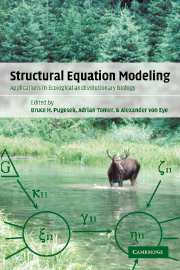Book contents
- Frontmatter
- Contents
- List of contributors
- Preface
- Section 1 Theory
- 1 Structural equation modeling: an introduction
- 2 Concepts of structural equation modeling in biological research
- 3 Modeling a complex conceptual theory of population change in the Shiras moose: history and recasting as a structural equation model
- 4 A short history of structural equation models
- 5 Guidelines for the implementation and publication of structural equation models
- Section 2 Applications
- Section 3 Computing
- Index
1 - Structural equation modeling: an introduction
Published online by Cambridge University Press: 14 October 2009
- Frontmatter
- Contents
- List of contributors
- Preface
- Section 1 Theory
- 1 Structural equation modeling: an introduction
- 2 Concepts of structural equation modeling in biological research
- 3 Modeling a complex conceptual theory of population change in the Shiras moose: history and recasting as a structural equation model
- 4 A short history of structural equation models
- 5 Guidelines for the implementation and publication of structural equation models
- Section 2 Applications
- Section 3 Computing
- Index
Summary
Abstract
This chapter provides an introduction to structural equation modeling (SEM), a statistical technique that allows scientists and researchers to quantify and test scientific theories. As an example, a model from behavioral genetics is examined, in which genetic and environmental influences on a trait are determined. The many procedures and considerations involved in SEM are outlined and described, including defining and specifying a model diagrammatically and algebraically, determining the identification status of the model, estimating the model parameters, assessing the fit of the model to the data, and respecifying the model to achieve a better fit to the data. Since behavioral genetic models typically require family members of differing genetic relatedness, multisample SEM is introduced. All of the steps involved in evaluating the behavioral genetic model are accomplished with the assistance of LISREL, a popular software program used in SEM.
- Type
- Chapter
- Information
- Structural Equation ModelingApplications in Ecological and Evolutionary Biology, pp. 3 - 41Publisher: Cambridge University PressPrint publication year: 2003
- 14
- Cited by

